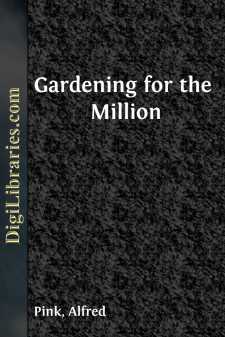Categories
- Antiques & Collectibles 13
- Architecture 36
- Art 48
- Bibles 22
- Biography & Autobiography 813
- Body, Mind & Spirit 142
- Business & Economics 28
- Children's Books 17
- Children's Fiction 14
- Computers 4
- Cooking 94
- Crafts & Hobbies 4
- Drama 346
- Education 46
- Family & Relationships 57
- Fiction 11829
- Games 19
- Gardening 17
- Health & Fitness 34
- History 1377
- House & Home 1
- Humor 147
- Juvenile Fiction 1873
- Juvenile Nonfiction 202
- Language Arts & Disciplines 88
- Law 16
- Literary Collections 686
- Literary Criticism 179
- Mathematics 13
- Medical 41
- Music 40
- Nature 179
- Non-Classifiable 1768
- Performing Arts 7
- Periodicals 1453
- Philosophy 64
- Photography 2
- Poetry 896
- Political Science 203
- Psychology 42
- Reference 154
- Religion 513
- Science 126
- Self-Help 84
- Social Science 81
- Sports & Recreation 34
- Study Aids 3
- Technology & Engineering 59
- Transportation 23
- Travel 463
- True Crime 29
Gardening for the Million
by: Alfred Pink
Description:
Excerpt
A
Aaron's Rod.—See "Solidago."
Abelia.—Very ornamental evergreen shrubs, bearing tubular, funnel-shaped flowers. They succeed in any ordinary soil if the situation is warm and sheltered, and are readily raised by cuttings. Height, 3 ft. to 4 ft.
Abies (Spruce Firs).—Among these ornamental conifers mention may be made of the beautiful Japanese Spruce Ajanensis, which grows freely in most soils and has dual-coloured leaves—dark green on the upper surface and silvery white underneath; this makes a grand single specimen anywhere. The White Spruce (Abies Alba Glauca) is a rapid grower, but while it is small makes a lovely show in the border; it prefers a moist situation. Of the slow-growing and dwarf varieties Gregorii is a favourite. The Caerulea, or Blue Spruce, is also very beautiful. Clanbrasiliana is a good lawn shrub, never exceeding 4 ft. in height. The Pigmy Spruce (A. Pygmea) is the smallest of all firs, only attaining the height of 1 ft. Any of these may be increased by cuttings.
Abronia.—Handsome half-hardy annual trailers. Grow in sandy peat and multiply by root division. Flowers in April. Height, 4 in. to 6 in.
Abutilon.—Evergreen greenhouse shrubs of great beauty and easy cultivation. May be raised from seed, or by cuttings of young shoots placed in spring or summer in sand under glass, or with a bottom heat. Cut the old plants back in January, and when new shoots appear re-pot the plants. Height, 5 ft. to 8 ft.
Acacia.—Winter and spring flowering greenhouse shrubs with charming flowers and graceful foliage. May be grown from seed, which should be soaked in warm water for twenty-four hours, or they may be propagated by layers, cuttings placed in heat, or suckers. They like a rich sandy loam soil. Height, 2 ft. to 3 ft.
Acæna.—These shrubby plants are herbaceous and mostly hardy, of a creeping nature, fast growers, and suitable for dry banks or rough stony places. They flourish best in sandy loam and peat, and may be increased by cuttings placed under glass. The flowers, which are green, are produced in May. The height of the various kinds varies from 3 in. to 2 ft.
Acantholimon Glumaceum (Prickly Thrift).—This is a frame evergreen perennial, thriving in any light, rich soil. It can be increased by dividing the roots. In May it puts forth its rose-coloured flowers. Height, 3 in.
Acanthus.—A coarse, yet stately hardy perennial, which has large ornamental foliage, and flowers in August. It is not particular as to soil or situation, but free space should be given it. Will grow from seed sown from March to midsummer, or in August or September in a sheltered situation. Will also bear dividing. Height, 3 ft.
Acer (Maple).—Very vigorous plants, suitable when young for pots, and afterwards for the shrubbery. The A. Negundo Variegata has silvery variegated leaves, which contrast effectively with dark foliage, Campestre Colchicum Rubrum, with its bright crimson palmate leaves, is very ornamental, as is also Negundo Californicum Aurem, with its golden-yellow foliage....












